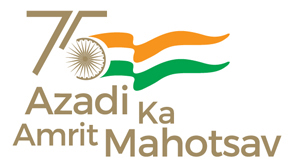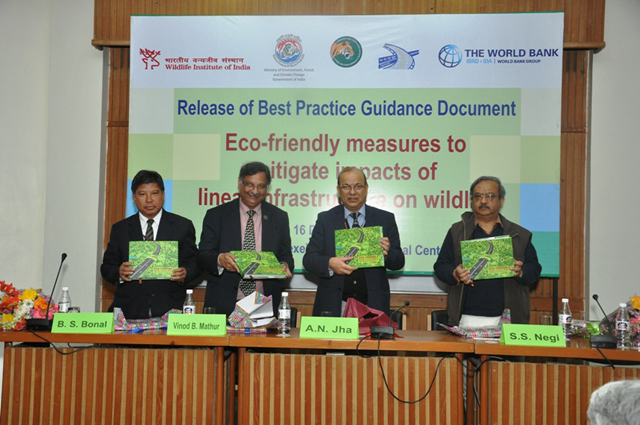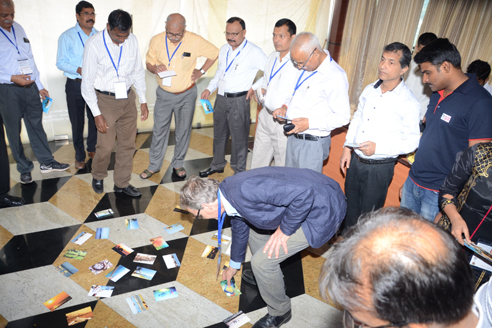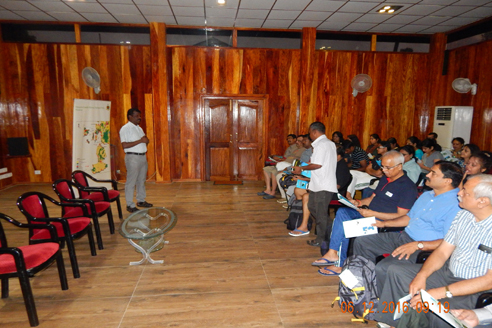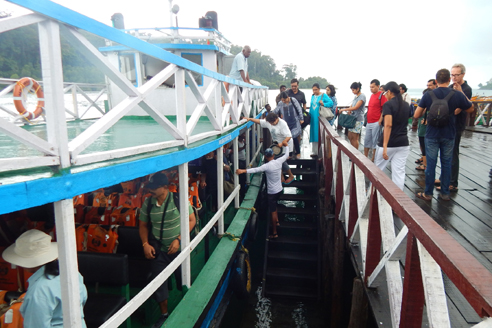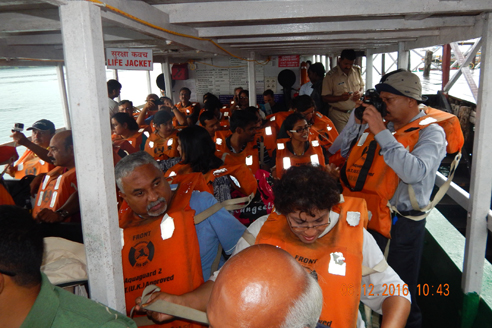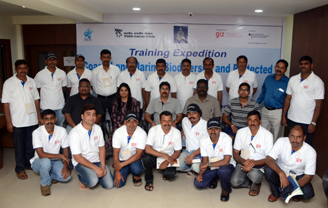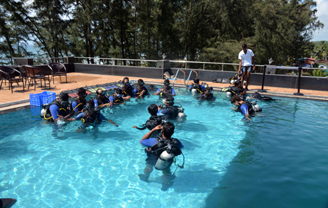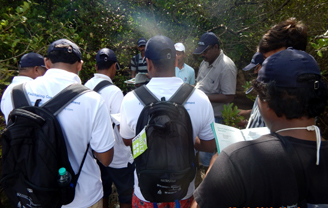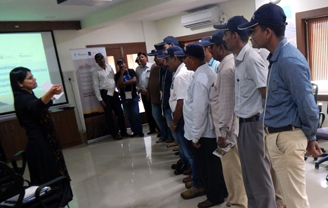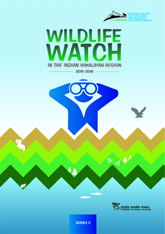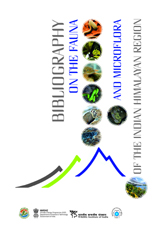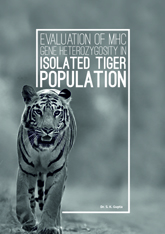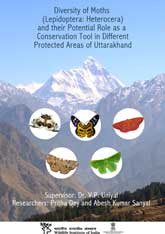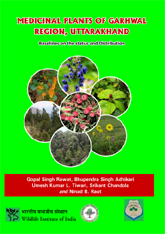Latest Events / News
-
Release of Best Practice Guidance “Eco-Friendly Measures to Mitigate Impacts of Linear Infrastructure on Wildlife” in Annexe, India International Centre, New Delhi on 16th December 2016
In response to the directive of the Ministry of Environment, Forest and Climate Change, Government of India, and to respond to the growing challenges of maintaining healthy, living landscapes by reducing the conflicts associated with the expanding linear developments such as road, railway lines and powerlines, Wildlife Institute of India developed the set of best practice guidance - Eco-Friendly Measures to Mitigate Impacts of Linear Infrastructure on Wildlife.
This guidance document was released by Shri A. N. Jha, Secretary, Ministry of Environment, Forest and Climate Change(MoEF&CC) in the presence of Dr. S. S Negi, Director General of Forests and Special Secretary to the Government of India; Shri. B. S. Bonal, Additional Director General of Forest (Wildlife), MoEFCC and Dr. V. B. Mathur, Director, Wildlife Institute of India on 16th December 2016 at the India International Centre in New Delhi. The publication of this document was possible with the support of several partners especially the National Highway Authority of India, Ministry of Road Transport and Highway, Govt. of India and the World Bank.
It is hoped that this document, the first for the country and for South Asia region, would serve as a valuable resource for planners, road and railway agencies and the powerline companies to enable them adopt smart solutions recommended in the guide to promote green infrastructure that would adequately address the need for 'development with caution’ in wildlife habitats within the integrated landscapes. Speaking on the occasion, Shri A. N. Jha Secretary, MoEF&CC complimented the Wildlife Institute of India for preparing such a document that would help to implement the practice of "Development without Destruction '. The challenge now is to ensure that mitigation measures that are proposed in the guidance document are actually implemented in the field, he added.
Last Updated: December 21, 2016 -
One-week refresher training course for Indian Forest Service Officers on “Management of Coastal and Marine Biodiversity in India: Challenges and Prospects”, from 5-9 December 2016 at Port Blair, A& N Islands
One-week refresher training course for Indian Forest Service Officers on “Management of Coastal and Marine Biodiversity in India: Challenges and Prospects” was organized jointly by MoEFCC, WII, GIZ and A&N Islands Forest Department from 5-9 December, 2016 at Port Blair, Andaman and Nicobar Islands. This course was designed to achieve the objective of promoting integrated management of coastal and marine biodiversity in India. A total of 19 participants from the different State Forest Department have participated in this training. Officers from various States including Andaman and Nicobar Islands, Gujarat, Kerala, Karnataka, Madhya Pradesh, Uttar Pradesh, Himachal Pradesh, Jammu and Kashmir, Arunachal Pradesh were participated. Resource persons from reputed organizations including Dr. V.B. Mathur, Director, WII, Dr. V.K. Melkani, PCCF(WL), TN, Dr. Alok Saxena, PCCF, ANI and Dr. Michael Vakily, GIZ, Mr M.S. Negi, PCCF(WL), ANI and Dr. K. Ravichandran, CCF(LW), ANI have provided inputs on diverse aspects of management, conservation and challenges in the coastal areas of India. This course was intended to enable the participants to have a sound understanding of the concepts and issues related to managing coastal and marine biodiversity, coastal and marine protected areas, ecological and socio-political context, conservation approaches and legal-policy frameworks between terrestrial and coastal marine PAs. The course curriculum and training methodologies that have been developed exclusively for this course were also shared with participants in both hard and soft copies. For further details, contact the Course Director Dr. K. Sivakumar at ksivakumar [at] wii [dot] gov [dot] in. 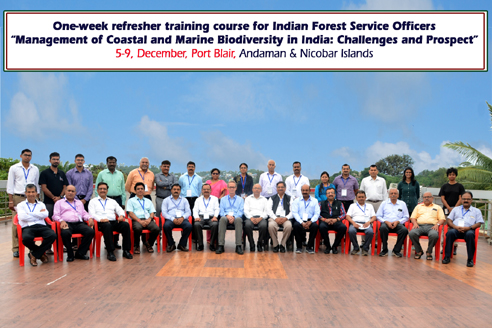
Last Updated: January 8, 2018 -
Inauguration of Landscape Ecology and Visualization Laboratory at WII
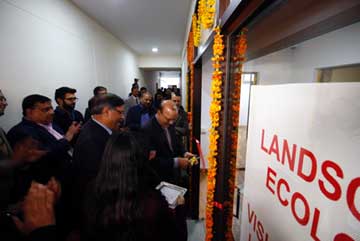 Inauguration of Landscape Ecology and Visualization Laboratory at WII The National Mission for Sustaining the Himalayan Ecosystem (NMSHE), a program under the National Action Plan for Climate Change by the Prime Minister’s Office, is being coordinated by the Department of Science and Technology (DST), Government of India. Six Task Forces have been identified and are being implemented by six national research institutes including Wildlife Institute of India (WII), which is the Task Force on “Micro flora and fauna, Wildlife and Animal Population”. Under the Task Force, WII is implementing the project “Assessment and Monitoring of Climate Change Effects on Wildlife Species and Ecosystems for Developing Adaptation and Mitigation Strategies in the Indian Himalayan Region”. One of the objectives of this project is to set up Landscape Ecology and Visualization Laboratory that allows (1) creation of inter-operable spatial database, (2) linking field data and GIS data, (3) detailed spatial analyses to understand various drivers of biodiversity responses, (4) modeling and scenario building, (5) 2D and 3D visualizations, (6) map production and (7) capacity building including stakeholder negotiations for developing adaptations and policy planning. Conceived and designed by WII, funded by DST under the NMSHE program, the facility was executed by CPWD, Dehradun, with regular technical inputs by project team and resident engineer. It is a pioneering state-of-art-facility integrating field-based biological research, data center, visualization and communication facility, teaching devices and map productions at one place.
Inauguration of Landscape Ecology and Visualization Laboratory at WII The National Mission for Sustaining the Himalayan Ecosystem (NMSHE), a program under the National Action Plan for Climate Change by the Prime Minister’s Office, is being coordinated by the Department of Science and Technology (DST), Government of India. Six Task Forces have been identified and are being implemented by six national research institutes including Wildlife Institute of India (WII), which is the Task Force on “Micro flora and fauna, Wildlife and Animal Population”. Under the Task Force, WII is implementing the project “Assessment and Monitoring of Climate Change Effects on Wildlife Species and Ecosystems for Developing Adaptation and Mitigation Strategies in the Indian Himalayan Region”. One of the objectives of this project is to set up Landscape Ecology and Visualization Laboratory that allows (1) creation of inter-operable spatial database, (2) linking field data and GIS data, (3) detailed spatial analyses to understand various drivers of biodiversity responses, (4) modeling and scenario building, (5) 2D and 3D visualizations, (6) map production and (7) capacity building including stakeholder negotiations for developing adaptations and policy planning. Conceived and designed by WII, funded by DST under the NMSHE program, the facility was executed by CPWD, Dehradun, with regular technical inputs by project team and resident engineer. It is a pioneering state-of-art-facility integrating field-based biological research, data center, visualization and communication facility, teaching devices and map productions at one place.The Landscape Ecology and Visualization Laboratory (LEVL) was formally inaugurated on 17 December 2016 by Shri Ajay Narayan Jha, Secretary to the Government of India (Ministry of Environment, Forest and Climate Change) at Wildlife Institute of India, Dehradun. Dr. V.B. Mathur, Director and Dr. G.S. Rawat, Dean of WII briefed the Secretary on the overall aim of such facility, while Dr. K. Ramesh, Scientist, along with the LEVL Team (Mr. Arun Kumar, Project Associate; Ms. Sujata Upgupta, Project Scientist and Ms. Tanvi, Project Fellow) made a detailed presentation on the evolution, objectives and operational components of the facility. The working of Laboratory will be interactive with project personnel and the stakeholders, and the outcome would be shared periodically, so that local solutions and adaptation strategies may be developed simultaneously. There is also a plan to design and execute concept-based and skill-based courses on landscape approach to natural resource management. It was placed on record the funding support by DST; execution by the CPWD and initial inputs by the University of British Columbia, Canada. The inauguration was attended by faculty members and Sectional Heads, research fellows of NMSHE project, staff of GIS and IT Cell of WII and staff of CPWD.
Speaking on the occasion Shri A.N.Jha, Secretary, MoEFFCC, who is also the Chairman of WII Governing Body appreciated the initiative taken by the Institute in establishing a state-of-the-art facility, which would greatly facilitate both environmental decision-making at the country-level and in articulating India's position during international negotiations. This 'inspiring facility' would also serve as a role model for other scientific institutions as well as for MoEFCC, he added.
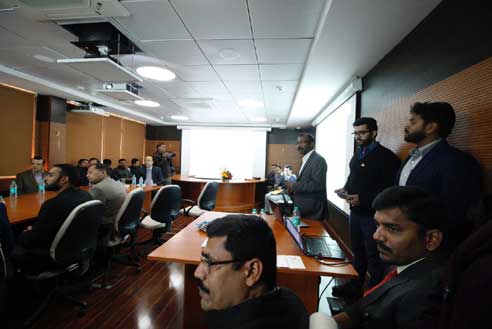
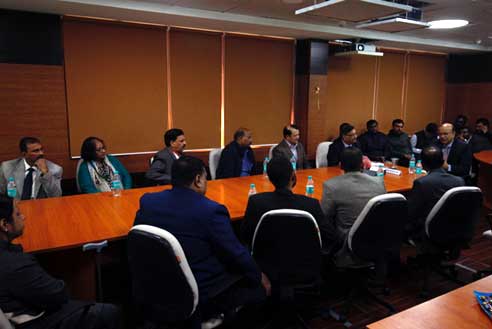
Last Updated: December 18, 2016 -
Summary of 5th Annual Coordination Meeting of the UNESCO World Heritage related Category 2 Institutes and Centres on 22nd November 2016
The 5th Annual Coordination Meeting of the UNESCO World Heritage related Category 2 Institutes and Centres took place in Dehradun, India on 22 November, 2016. The UNESCO Category 2 Centre (C2C) on Natural World Heritage Management and Training for Asia and the Pacific Region (NWHMT) at the Wildlife Institute of India (WII) hosted the meeting in its campus. Four Coordination Meetings have taken place so far in 2010 (Manama, Bahrain), 2012 (Milan, Italy), 2013 (Oslo, Norway) and 2014 (Shanghai, China). The objective of this meeting was to build institutional capacity through a focus on international cooperation and to build synergies for effective natural heritage conservation.
19 representatives from the UNESCO World Heritage Centre, Advisory Bodies, Regional Institutes and Universities, UNESCO Chairs and four Category 2 Centres participated in the meeting. Dr. V.B. Mathur, Director UNESCO C2C at WII welcomed the participants and briefed about the purpose of the 5th Annual Coordination Meeting and also gave an overview of mandate and activities of the newly established C2C at WII. In her inaugural address, Dr. Mechtild Rossler, Director World Heritage Centre, Paris highlighted the role of World Heritage Category 2 Centres in complementing the work of UNESCO. The meeting was organized in three technical sessions in which review of actions taken from previous C2C coordination meetings; progress and activities of each Category 2 Centre and Institutes and road map for enhancing collaborations and cooperation amongst C2Cs was discussed.
The UNESCO C2C at WII Monsoon bulletin was also launched during this meeting and is available on the following website link http://www.wii.gov.in/UNESCO_C2C_Monsoon_Bulletin_2016.
The 5th Annual Coordination Meeting was followed by two Consultative Dialogues on “Kailash Sacred Landscape” and “Cultural Landscapes, Mixed and Transboundary Heritage Sites” on 23rd November and 24th -25thNovember, 2016 respectively in which over 100 representatives from UNESCO, IUCN, ICOMOS, INTACH and State Forest Departments, Universities participated.
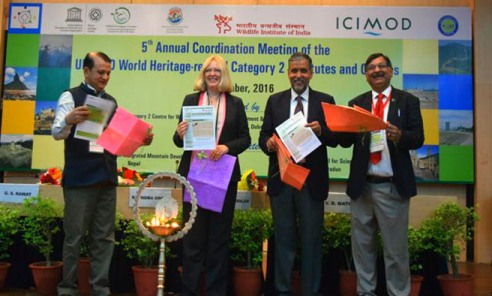
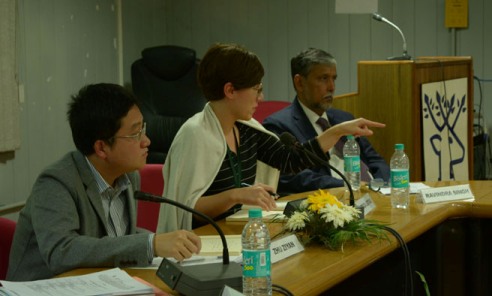
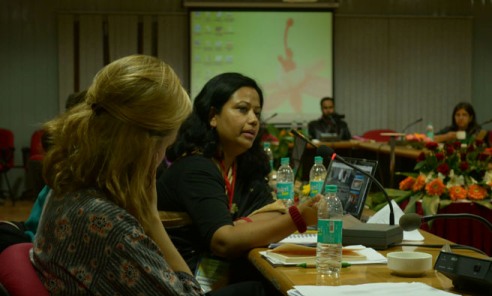
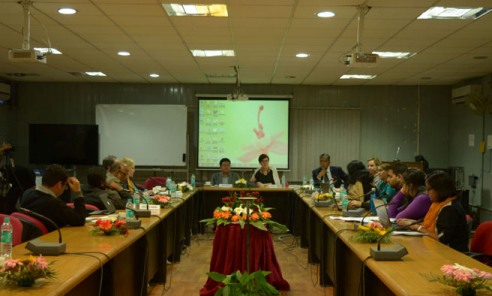
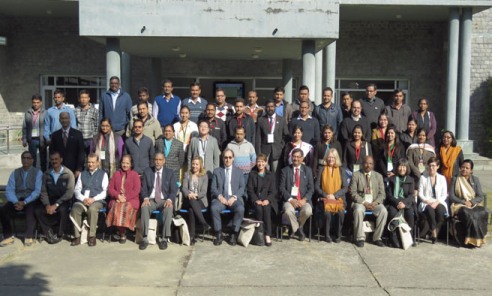
Last Updated: November 24, 2016 -
UNESCO C2C Natural Heritage Bulletin Monsoon - 2016
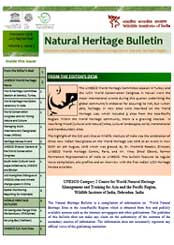
UNESCO C2C Natural Heritage Bulletin Monsoon - 2016
Download E-Bulletin (2.9 mb)
(2.9 mb)
Last Updated: November 24, 2016 -
Asian Ministerial Conference on Disaster Risk Reduction, November 3-5, 2016
This First Asian Ministerial Conference for Disaster Risk Reduction (AMCDRR) after the advent of the Sendai Framework was hosted by the Government of India from 3rd -5th November 2016. The intended outcome of the conference was to adopt as ‘Asian Regional Plan for Implementation of the Sendai Framework’. The conference provided a unique opportunity to shape the implementation and monitoring of the Sendai Framework in Asia by transforming the commitment of governments and stakeholders into national and local action and setting the direction to accelerate regional implementation and monitoring of the Sendai Framework.
In AMCDRR 2016, UNESCO Category 2 Centre on World Natural Heritage Management and Training for Asia and the Pacific Region at Wildlife Institute of India, Dehradun organised a thematic session on ‘Making World Heritage Risk Resilient’ along with Tata Institute of Social Sciences (TISS) - Jamsetji Tata school of Disaster Management and Development & Research Organization for Arts and Natural Heritage (DRONAH) as collaborators. The objective was to influence policy and action for better management and protection of Natural and Cultural World Heritage Sites for Disaster Risk Reduction and to interact and provide a knowledge platform for promoting DRR solutions through World Heritage Sites to policy makers and practitioners in Asia-Pacific Region.
This thematic session emphasised the need for countries to develop concerted policies and plans on disaster risk reduction for World Heritage Sites and also to examine how world heritage conservation could foster resilience. It brought together experts from both natural and cultural heritage areas who reflected on the current situation, the potential threats and consequences and also helped to identify the way ahead in terms of appropriate frameworks, existing practices and protocols, policies and perhaps trainings that will be required to enhance sensitivity of the many actors involved in creating robust DRR strategies for world heritage sites in the Asian region.
The outputs from the session were development of a framework for integration of Natural and Cultural heritage conservation concerns into Regional disaster reduction policies; and mainstreaming of disaster risk reduction within management plans and systems for World Heritage properties in their territories.
The session was moderated by Dr. Sonali Ghosh, Scientist and Faculty UNESCO C2C, which included 3 key speakers viz. Shri Vinay Sheel Oberai, Secretary, MoHRD, Dr. V.B. Mathur, Director, UNESCO C2C & Wildlife Institute of India and Dr. Mitrasen Bhikajee, Deputy Director, UNESCO, New Delhi and 12 panellists viz. Dr. Janki Andharia, TISS, Mumbai, Dr. Shikha Jain, DRONAH, Ms. Vanicka Arora, NDMA, Prof. Dr. Sudibyakto, Advisory Board of BNPB (Indonesia), Mr. Anshuman Saikia, Regional Programme Support Coordinator, IUCN Asia, Mr. Jeremy England, President International Committee of the Red Cross-India, Dr. Navin Piplani, Principal Director, INTACH, Ms Margherita Fanchiotti, UNESCO, Dr. Shirish Ravan, UNOOSA and Dr. Ram Boojh, Programme Specialist, Natural Science, UNESCO.
The whole session can be viewed on You Tube link: https://www.youtube.com/watch?v=HRi9qoftCUs
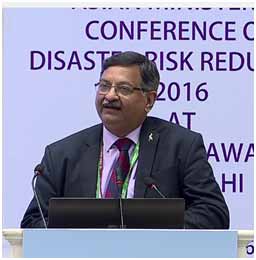
Director, UNESCO Category 2 Centre-WII on Natural WHS and DRR
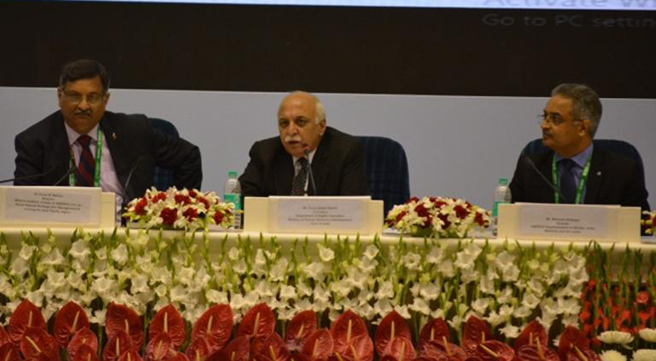
Shri V.S. Oberoi, Chair of the session addressing the audience
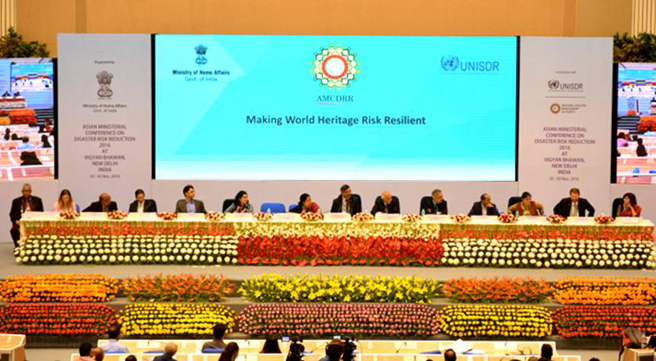
Keynote Speaker and Panel Discussants
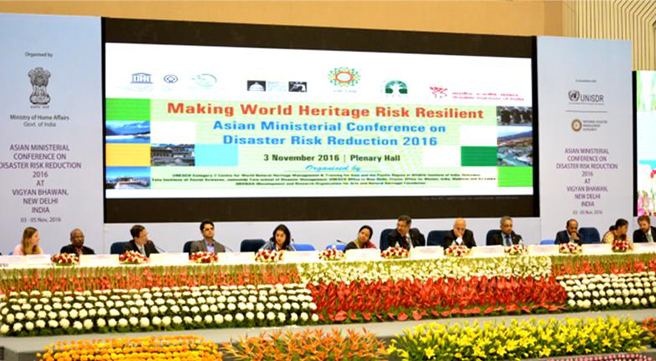
Panel Discussant participating in the discussion 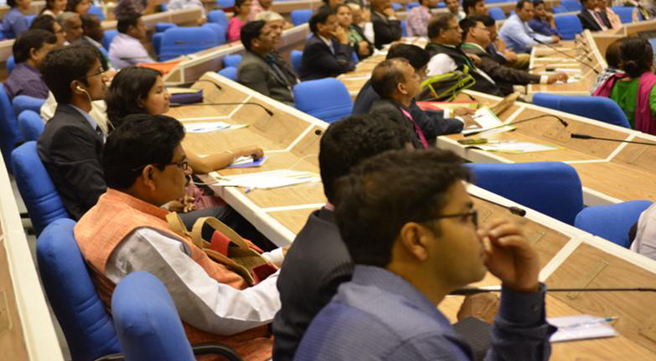
Audience during the session
Last Updated: November 18, 2016 -
Second Training Expedition on ‘Coastal and Marine Biodiversity and Protected Area Management in Gujarat’, 24-26 October, 2016 at Jamnagar, Gujarat
Conservation and Sustainable Management of Coastal and Marine Protected Areas (CMPA)” project of the Indo-German Biodiversity Programme of GIZ aims at strengthening capacities of key training and learning organizations relevant to Marine Protected Areas (MPAs). In this context, a “Special Training Expedition on Coastal and Marine Biodiversity and Protected Area Management” for field-level staff of the Gujarat Forest Department was organized on 24-26 October, 2016 at Jamnagar, in Gujarat. This program was jointly organized by the Wildlife Institute of India and Deutsche Gesellschaft für Internationale Zusammenarbeit (GIZ) GmbH, CAMPA-Dugong Project and Gujarat Forest Department. This course was intended to enable the participants to have a sound understanding of the concepts and issues related to managing coastal and marine biodiversity, coastal and marine protected areas, ecological and socio-political context, conservation approaches and legal-policy framework between terrestrial and coastal marine PAs, as well as to acquire necessary skills to conduct assessment and monitoring of coastal and marine habitats and species and prepare field reports, and develop-under supervision-operational plan for MPAs based on management effectiveness guidelines. A total of 18 participants from the Gujarat Forest Department have participated in this training expedition. The course curriculum and training methodologies that have been developed exclusively for this course. For further details, contact the Course Director Dr. K. Sivakumar at ksivakumar [at] wii [dot] gov [dot] in.
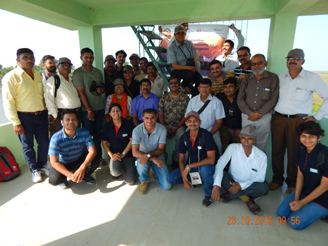
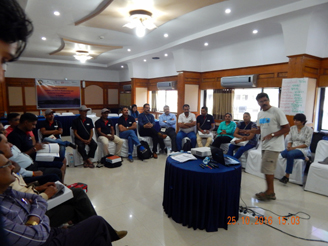
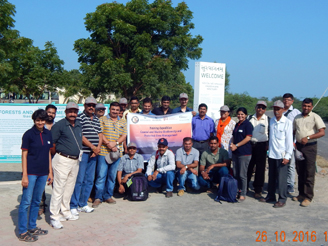
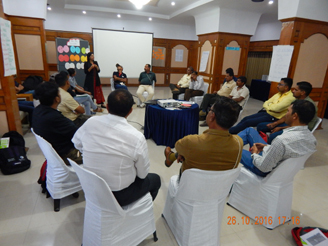
Last Updated: January 6, 2018 -
Training Expedition on ‘Integrated Management of Coastal and Marine Protected Areas in Maharashtra’, 4-7 October, 2016 at Malvan, Maharashtra
Conservation and Sustainable Management of Coastal and Marine Protected Areas (CMPA)” project of the Indo-German Biodiversity Programme of GIZ aims at strengthening capacities of key training and learning organizations relevant to Marine Protected Areas (MPAs). In this context, a “Special Training Expedition on Coastal and Marine Biodiversity and Protected Area Management” for field-level staff of the Maharashtra Forest Department was organized on 4-7 October, 2016 at the Indian Institute of Scuba Diving and Aquatic Sports (IISDA) at Tarkarli, in Malvan Maharashtra, jointly organized by the Wildlife Institute of India and Deutsche Gesellschaft für Internationale Zusammenarbeit (GIZ) GmbH and Maharashtra Forest Department. This course was intended to enable the participants to have a sound understanding of the concepts and issues related to managing coastal and marine biodiversity, coastal and marine protected areas, ecological and socio-political context, conservation approaches and legal-policy framework between terrestrial and coastal marine PAs, as well as to acquire necessary skills to conduct assessment and monitoring of coastal and marine habitats and species and prepare field reports, and develop-under supervision-operational plan for MPAs based on management effectiveness guidelines. A total of 19 participants from the Maharashtra Forest Department and IISDA have participated in this training expedition. The course curriculum and training methodologies that have been developed exclusively for this course. For further details, contact the Course Director Dr. K. Sivakumar at ksivakumar [at] wii [dot] gov [dot] in.
Last Updated: January 6, 2018 -
XXX Annual Research Seminar - Release of Publications
Plug-in: Download Adobe Acrobat Reader
Last Updated: October 4, 2016 -
7th Himalaya Day at Nayar River

The ‘Himalaya Day’ is celebrated on 9th September since 2010 to create awareness to save the Himalayan range as it provides life line for millions of people living in the mountains and in the northern plains of India. The Wildlife Institute of India celebrates this day each year by organizing training workshops, talks and seminars. This year, the theme for ‘Himalaya Day’ Celebration is ‘Ecological Services of Rivers’. Therefore, WII celebrated the 7th Himalaya Day by organizing a training-cum-conservation Awareness Workshop on ‘Ecological Services of the Himalayan Rivers’ at the bank of River Nayar in Pauri District, which is one of the most important rivers for Golden Mahseer conservation in Uttarakhand. This workshop was organized under the National Mission for Sustaining the Himalayan Ecosystem project funded by Department of Science and Technology. A total of 70 participants comprising of school students, forest officials, staff from Uttarakhand Forest Department and representatives of the fishermen community of the area have participated in this workshop that was organised at Government Inter College at Bilket, Pauri. The workshop was inaugurated with messages to conserve the Himalaya and its biodiversity by Dr. S. Sathyakumar (WII), Mr. H. Kestwal (Inter College, Bilkhet), Mr. Gireesh Kumar Rustgoi (CF) and Mr. Ramesh Chander (DFO). Dr. Anoop Dobrial, Head, Department of Zoology, H.N.B. Garhwal University, Pauri campus was the chief guest for the workshop and he has delivered a talk on ‘Ecological Services of Himalayan Rivers’. A hands-on training was given by Dr. K. Sivakumar and Dr. J. A. Johnson, on the river bank of Nayar. All the participants were then divided into groups and provided hand-on training on river habitat quality assessment and restoration techniques. Harmful effects of destructive fishing and dredging were also explained along with various scientific techniques. Prizes were distributed for the bright students based on a quiz. The closing remarks were given by Dr. V. P. Uniyal, Scientist, WII on the need to organize similar workshops/trainings for the youth in future. Dr. Vineet Dubey and Ms. Aashna Sharma concluded the workshop with vote of thanks to all.
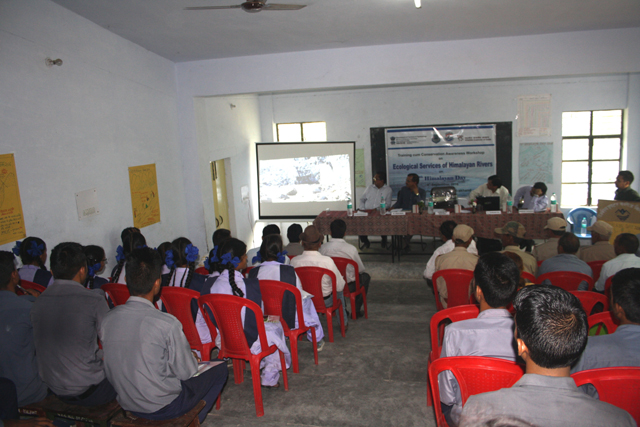
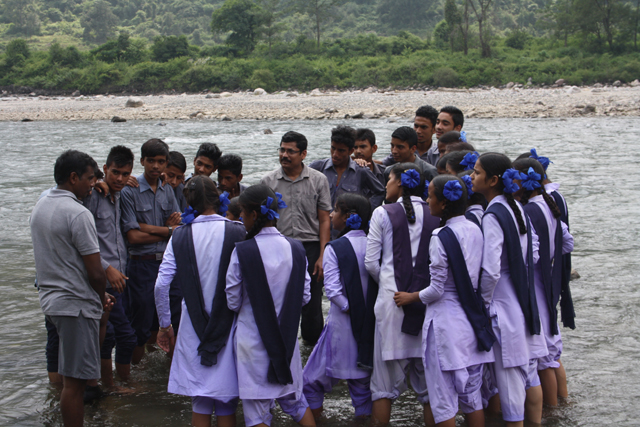
Last Updated: September 12, 2016

